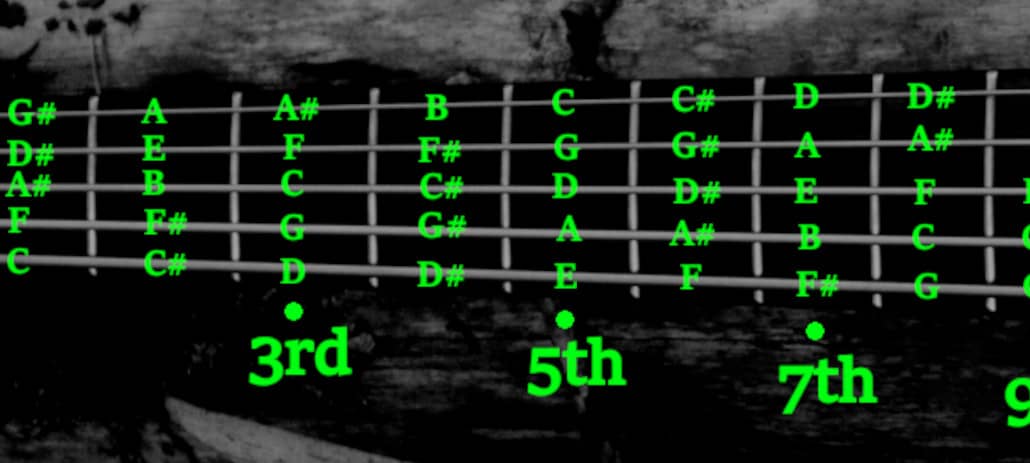As a bass player, knowing where to find different notes on the fretboard is a fundamental and crucial skill. This holds true regardless of whether you play a 4, 5, or even a 7-string.
With that said, most learning resources I`ve seen have been aimed at 4-string basses. Thus, it can be hard to learn where to find the notes on a 5-string bass.
Therefore, I decided to make a 5-string bass notes chart that will make the learning process easier for you 5-string players out there.
First off, I will present you with a 5-string bass chart for B standard tuning. I will also show you some neat tricks for how to memorize certain important notes.
I`ve also made some 5-string bass note charts for alternate tunings. These charts will show you how to navigate the fretboard regardless of how you tune your bass.
Standard Tuning
First off, here is a chart of every single note on a 5-string bass in standard tuning.
This tuning is called B standard. It is the go-to tuning for 5-string basses and most 5-string bass tabs are written in this tuning.

Notice that the 12th fret is always the same note as the open string. For example, the 12th fret of the B string is a B, and the 12th fret of the A string is an A.
This also means that the pattern of the notes starts repeating after the 12th fret. For example, the 1st and 13th fret of the B string is C, and the 2nd and 14th fret are both C#.
Most importantly, despite there being 120 notes on a 24-fret 5-string bass, there are only 12 different ones. The 12 notes are:
- A
- A# / Bb
- B
- C
- C# / Db
- D
- D# /Eb
- E
- F
- F# / Gb
- G
- G# /Ab
In other words, while the above notes chart can seem overwhelming at first, it has a clear pattern to it. There are only a handful of notes and they appear in a pattern that will start to make sense over time.
Therefore, if you are unfamiliar with the name of the notes on the 5-string bass, the above chart is immensely helpful. This is because you can use it both to practice memorizing where notes are found or as a cheat sheet when needed.
Key Frets & Octaves
A great way to navigate a 5-string neck is by using the dots on the bass. At the dotted frets, you will find some key notes that are used in a lot of songs. Most notably, the 5th, 7th, and 12th have notes that work as a great starting spot for learning the rest of the neck.
Thus, if you are currently finding the whole neck intimidating right now, focus on these notes. From experience, I can promise you that memorizing these first makes playing the rest of the neck a whole lot easier:

Lastly, it helps to know how to find octaves. An octave is simply the same note played at a higher frequency.
The lowest note on a 5-string bass is a B, or more precisely, a B0. At the 12th fret of the same string, we also find a B, but this is a B1, which is an octave higher.
Identifying where octaves are found is another way to make navigating the neck on your 5-string bass easier. In the following chart, every B on the neck is highlighted. Thus, you can use it to learn the fretboard while memorizing where to find octaves at the same time.

Drop Tuning
All of the above examples assume the bass is tuned to B standard. This is by far the most common 5-string tuning and one that many bassits never stray away from.
However, this does not mean that 5-strings cannot be tuned in other ways. In fact, lots of songs are played in drop tunings, particularly in metal and rock music.
Therefore, it’s helpful to be aware that bass guitars can make use of other tunings than B standard. Even if you don`t intend to play heavy music, you might run into these tunings from time to time.
Luckily, drop tunings are similar to that of standard tunings. As an example, here is what the notes on a 5-string bass tuned to Drop A looks like:

It is called drop A because the deepest string is dropped 1 whole step from B to A. As you might have noticed, the other 4 strings are thus the same as in B standard.
Other drop tunings will differ more from B standard, but they will all share the same pattern as Drop A. The thickest string will be dropped deeper, whereas the rest of them will be tuned at perfect fourths.
Alternate Standard Tuning
Above, I compared B standard to Drop A. While drop tunings are a common way to alternate the tuning of a 5-string bass, there are also other alternate standard tunings than B standard.
These tunings all have the same pattern and intervals as B Standard. They will, however, all have a different pitch. As an example, A Standard tunes every string 1-whole step down from B standard. Here is a notes chart for what A standard looks like on a 5-string bass:

This makes the tunings easier to adapt to. This is because while the name of bass strings changes, the intervals between them do not. Thus, if you ever find yourself playing in this tuning, you can use everything you already know about B standard.
The only difference is that you need to remember that each note now sounds a whole step deeper. Thus, if you know where to find G on the neck in B standard, you will need to play this note 2 frets higher up.
Conclusion
Learning to play the 5-string bass as a beginner can feel overwhelming. Luckily, this is something that becomes significantly easier over time and will become second nature before you even know it.
Feel free to check out my bass guitar notes chart that is more tailored towards 4-string basses. There, I share some general tips on remembering the notes on a bass’s neck. It can also be a good option for beginners if you want to ignore the B string for now.
Regardless, by focusing on learning the 5-string bass notes and where to locate them you are on the right track.
I can tell you from experience that by focusing on this now, learning new songs and techniques will become much easier going forward. Therefore, I recommend keeping at it and regularly using the charts in this article to improve your knowledge of the neck of your 5-string bass.

